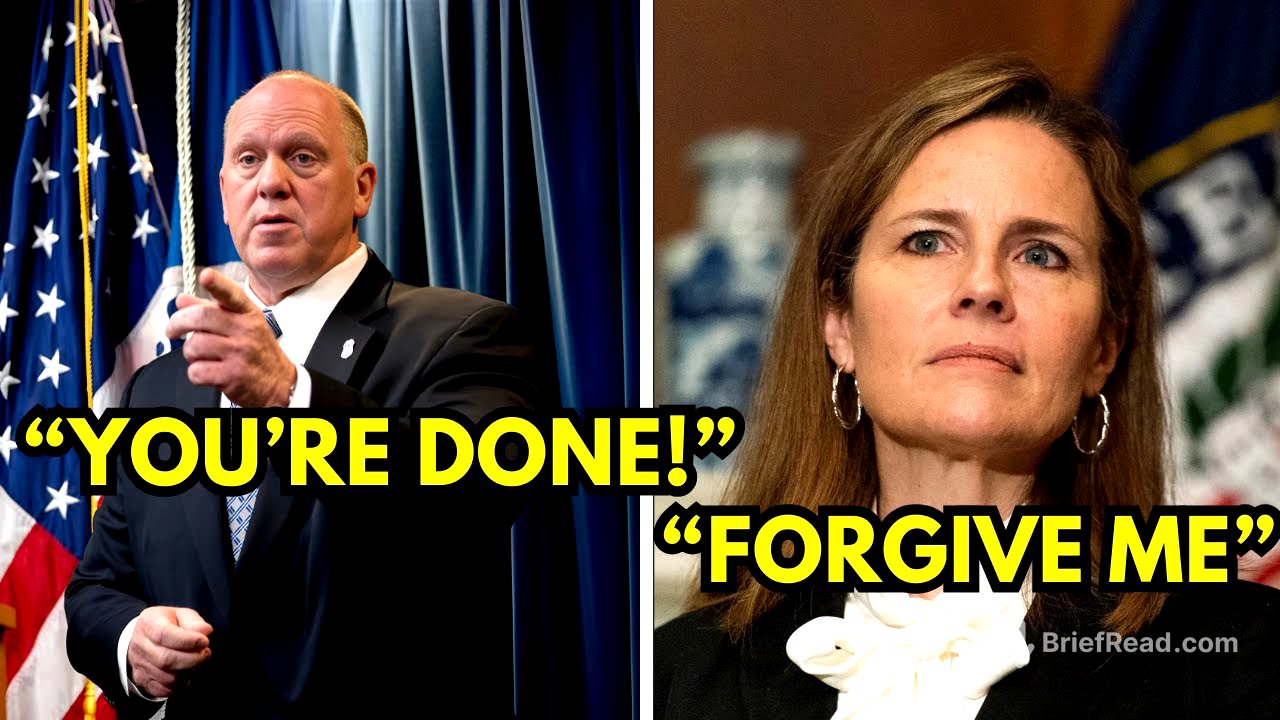TLDR;
The Supreme Court case of United States v. Ramirez centers on the legality of "Operation Safe Borders," an ICE initiative led by Tom Homan. The operation's aggressive enforcement tactics are challenged as a violation of the Fourth Amendment. Justice Amy Coney Barrett emerges as a key figure, scrutinizing the government's arguments and emphasizing the importance of constitutional protections for all individuals within U.S. jurisdiction. The court ultimately rules against the government, asserting that constitutional principles cannot be compromised for the sake of policy goals.
- The case examines the balance between national security and individual rights in immigration enforcement.
- Justice Barrett's role is pivotal in upholding constitutional principles.
- The ruling establishes that the Fourth Amendment applies to everyone within U.S. jurisdiction, regardless of immigration status.
Setting the Stage: The Supreme Court Hears United States v. Ramirez [0:00]
The Supreme Court is poised to hear United States v. Ramirez, a significant immigration case focusing on the legality of immigration enforcement tactics. The atmosphere is tense as reporters, legal scholars, and spectators anticipate the arguments. The nine justices, including Chief Justice John Roberts and Associate Justice Amy Coney Barrett, prepare to preside over the case. Tom Homan, former acting director of ICE, is present, his controversial legacy hanging in the balance as the court examines one of his most debated operations.
Amy Coney Barrett's Judicial Philosophy [3:11]
Justice Amy Coney Barrett, appointed in 2020, brings a formidable intellect to the Supreme Court. As a textualist, she adheres to the Constitution's original meaning. Despite her conservative credentials, Barrett has shown a willingness to break with conservative orthodoxy when legal principles demand it. Her vote in United States v. Ramirez could be decisive, as the case pits executive power against individual rights and federal authority against constitutional protections.
Operation Safe Borders: An Overview [4:36]
Operation Safe Borders, an ICE initiative led by Tom Homan in 2021, aimed to enforce immigration laws without compromise. Federal agents conducted raids across the Southwest, targeting workplaces, schools, and residential areas. Hundreds of undocumented immigrants were detained, leading to accusations of humanitarian disaster and civil rights violations. While Homan argued the operation targeted criminal networks, critics claimed it trampled due process and ensnared innocent families.
Legal Challenges and the Biden Administration's Stance [7:19]
Legal challenges to Operation Safe Borders moved slowly through the courts. Civil rights organizations and immigration attorneys filed emergency petitions and worked to support affected families. The Biden administration, seeking to distance itself from Homan's policies, allowed the legal challenge to reach the Supreme Court, hoping for a definitive ruling on immigration enforcement.
Oral Arguments Begin: Thompson Presents the Government's Case [8:27]
Sarah Thompson, the government's attorney, argues that ICE acted within its statutory authority under the Immigration and Nationality Act. She asserts that Operation Safe Borders was a lawful response to transnational criminal networks. Justice Barrett questions the government's justification for warrantless raids in residential areas, pressing Thompson on potential Fourth Amendment violations.
Barrett's Skepticism and Thompson's Defense [10:59]
Thompson defends the government's position by arguing that the Fourth Amendment allows flexibility in immigration enforcement. Barrett challenges this, pointing out that agents entered private homes without judicial oversight and detained individuals without probable cause. Thompson argues that national security and border integrity justify the government's actions, but Barrett remains skeptical.
Ramirez Argues Against Operation Safe Borders [13:06]
Miguel Ramirez, representing the detained immigrants, argues that Operation Safe Borders was a constitutional overreach. He emphasizes that the Fourth Amendment protects everyone on U.S. soil, regardless of documentation status. Justice Thomas questions whether Ramirez's argument would undermine the federal government's authority to enforce immigration laws.
Distinguishing Precedent and Addressing Constitutional Limits [15:31]
Barrett questions Ramirez about the precedent set by United States v. Martinez-Fuerte, which upheld warrantless immigration stops at fixed checkpoints. Ramirez distinguishes that case, arguing that Operation Safe Borders involved invasive searches and detentions without individualized suspicion. He asserts that the Constitution doesn't shrink based on location or immigration status.
Homan's Frustration and Klene's Defense [17:17]
Tom Homan expresses frustration with the legal proceedings, believing they ignore the realities of law enforcement. His attorney, Robert Klene, argues that accepting the respondent's argument would cripple immigration enforcement. Barrett questions Klene about whether undocumented immigrants possess any Fourth Amendment protections.
Barrett's Constitutional Purism and Roberts' Shift in Focus [19:30]
Barrett challenges Klene's argument, emphasizing that the Fourth Amendment contains no immigration exception. Chief Justice Roberts redirects the argument, asking Thompson how Section 287A2 of the Immigration and Nationality Act justifies the arrests. Thompson argues that ICE acted on intelligence suggesting imminent flight risks and ongoing criminal activity.
Sotomayor's Skepticism and Homan's Outburst [22:18]
Justice Sotomayor questions whether detainees with established ties to their communities were genuinely flight risks. Thompson argues that individual risk assessments aren't always feasible in large-scale operations. Homan, frustrated by the proceedings, interrupts to assert that the individuals detained violated federal law and are connected to criminal organizations.
Barrett's Decisive Question and the Exclusionary Rule [25:05]
Barrett poses the decisive question: if a Fourth Amendment violation is found, what remedy is appropriate? She questions whether the exclusionary rule applies in immigration contexts. Klene argues that the exclusionary rule doesn't serve a meaningful deterrent purpose in immigration proceedings.
Ginsburg's Intervention and the Private Conference [26:34]
Justice Ginsburg asserts that internal disciplinary rules don't replace judicial enforcement of constitutional rights. The justices hold a private conference, with Barrett emerging as a pivotal voice in deliberations. She argues that the case is about whether executive convenience can override constitutional limits.
Deliberations and the Decision [27:53]
Justice Gorsuch expresses concerns about the practical implications of Barrett's position. Barrett responds that practical inconvenience doesn't override constitutional text. Chief Justice Roberts attempts to find middle ground, but Barrett stands firm. The justices reach a narrow 5-4 decision for the respondents.
The Ruling and Its Aftermath [29:36]
Barrett's majority opinion asserts that the government's interest in immigration control doesn't justify abandoning constitutional protections. The exclusionary rule must apply to ensure that constitutional violations carry consequences. Homan is dismayed by the ruling, while Barrett sees it as a victory for constitutional principle. The nation reacts strongly, with civil rights advocates praising the decision and border security advocates condemning it. The Supreme Court establishes that the Constitution applies to everyone within American jurisdiction, and government power must operate within constitutional constraints.








